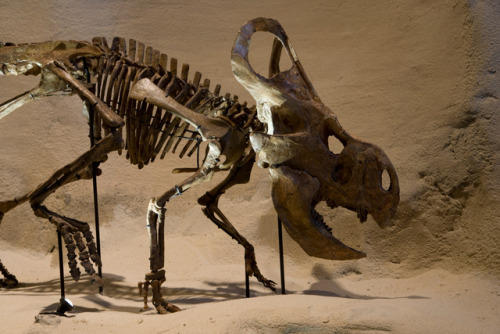
Protoceratops andrewsi is a fairly small and primitive ceratopsian, or horned dinosaur. Although it lacked the horns of later species, Protoceratops had a distinct bump above its nostrils and thickened bone over its eye sockets. Like its larger and geologically younger relative Triceratops, this herbivore also had a bony neck frill that may have been used for species identification and display. With a name that means “Andrews’ early horned face,” this dinosaur reached two and one-half feet tall at the hips and grew up to six feet long. It weighed around 200 pounds and had a horn-covered beak that it used to crop plants and to defend itself.
Protoceratops was first discovered in Mongolia, and a great many specimens have since been found in that nation and in northern China. They range in size from hatchlings to full-grown adults, including one that is preserved locked in combat with an individual of Velociraptor, the predatory ‘raptor’ made famous by the Jurassic Park films.
Protoceratops thrived in Central Asia during the late Cretaceous Period, roughly 80-75 million years ago. Roughly 20 million years beforehand, a ceratopsian species that closely resembled Protoceratops is thought to have migrated from Asia to North America via a land bridge that spanned the region between what are now Siberia and Alaska. The descendants of this dinosaur eventually evolved into the huge horned ceratopsians such as Triceratops.
The Protoceratops on display at Carnegie Museum was collected by the American Museum of Natural History during an expedition to Mongolia in 1925 and obtained via an exchange in 1945.
